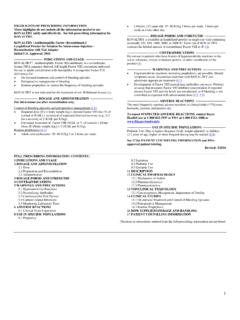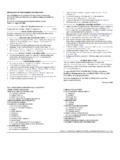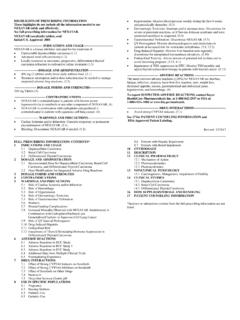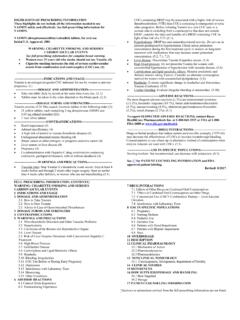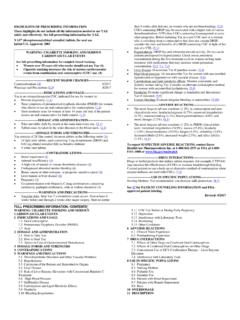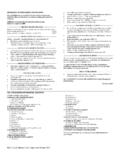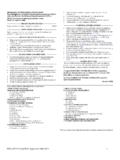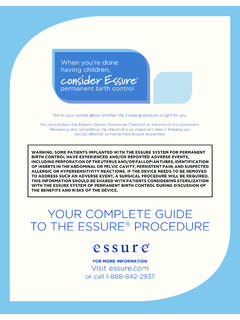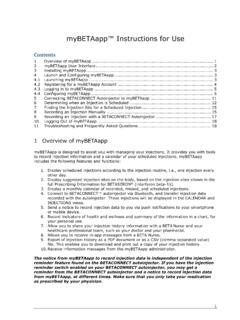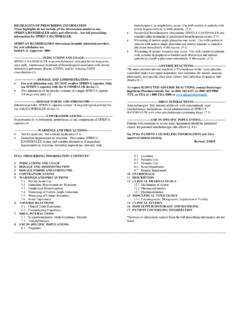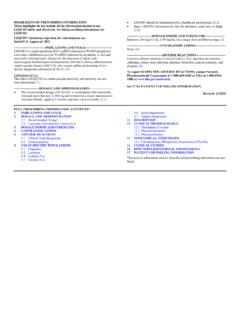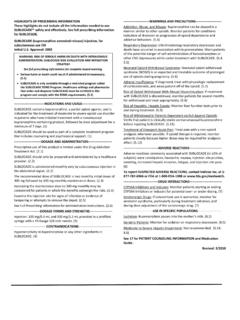Transcription of See full prescribing information for complete boxed ...
1 1 HIGHLIGHTS OF prescribing information These highlights do not include all the information needed to use STIVARGA safely and effectively. See full prescribing information for STIVARGA. STIVARGA (regorafenib) tablets, for oral use Initial Approval: 2012 --------------------------- indications AND usage -------------------------- STIVARGA is a kinase inhibitor indicated for the treatment of patients with: Metastatic colorectal cancer (CRC) who have been previously treated with fluoropyrimidine-, oxaliplatin- and irinotecan-based chemotherapy, an anti-VEGF therapy, and, if RAS wild-type, an anti-EGFR therapy. ( ) Locally advanced, unresectable or metastatic gastrointestinal stromal tumor (GIST) who have been previously treated with imatinib mesylate and sunitinib malate. ( ) Hepatocellular carcinoma (HCC) who have been previously treated with sorafenib ( ) ---------------------- DOSAGE AND ADMINISTRATION ---------------------- Recommended dose: 160 mg orally, once daily for the first 21 days of each 28-day cycle.
2 ( ) Take STIVARGA after a low-fat meal. ( , ) --------------------- DOSAGE FORMS AND STRENGTHS -------------------- Tablets: 40 mg (3) ------------------------------ CONTRAINDICATIONS ----------------------------- None. ----------------------- WARNINGS AND PRECAUTIONS ---------------------- Hepatotoxicity: Monitor liver function tests. Withhold and then reduce or discontinue STIVARGA based on severity and duration. ( ) Infections: Withhold STIVARGA in patients with worsening or severe infections. ( ) Hemorrhage: Permanently discontinue STIVARGA for severe or life-threatening hemorrhage. ( ) Gastrointestinal perforation or fistula: Discontinue STIVARGA. ( ) Dermatologic toxicity: Withhold and then reduce or discontinue STIVARGA depending on severity and persistence of dermatologic toxicity. ( ) Hypertension: Temporarily or permanently withhold STIVARGA for severe or uncontrolled hypertension. ( ) Cardiac ischemia and infarction: Withhold STIVARGA for new or acute cardiac ischemia/infarction and resume only after resolution of acute ischemic events.
3 ( ) Reversible posterior leukoencephalopathy syndrome (RPLS): Discontinue STIVARGA. ( ) Risk of impaired wound healing: Withhold for at least 2 weeks prior to elective surgery. Do not administer for at least 2 weeks after major surgery and until adequate wound healing. The safety of resumption of STIVARGA after resolution of wound healing complications has not been established. ( ) Embryo-fetal toxicity: Can cause fetal harm. Advise women of potential risk to a fetus and to use effective contraception during treatment and for 2 months after the final dose. Advise males to use effective contraception for 2 months after the final dose. ( , , ) ------------------------------ ADVERSE REACTIONS ----------------------------- The most common adverse reactions ( 20%) are pain (including gastrointestinal and abdominal pain), HFSR, asthenia/fatigue, diarrhea, decreased appetite/food intake, hypertension, infection, dysphonia, hyperbilirubinemia, fever, mucositis, weight loss, rash, and nausea.
4 (6) To report SUSPECTED ADVERSE REACTIONS, contact Bayer HealthCare Pharmaceuticals Inc. at 1-888-842-2937 or FDA at 1-800-FDA-1088 or ------------------------------ DRUG INTERACTIONS ----------------------------- Strong CYP3A4 inducers: Avoid strong CYP3A4 inducers. ( ) Strong CYP3A4 inhibitors: Avoid strong CYP3A4 inhibitors. ( ) BCRP substrates: Monitor patients closely for symptoms of increased exposure to BCRP substrates. ( ) ----------------------- USE IN SPECIFIC POPULATIONS ---------------------- Nursing Mothers: Discontinue drug or nursing, taking into consideration the importance of the drug to the mother. ( ) See 17 for PATIENT COUNSELING information and FDA-approved patient labeling. Revised: 12/2020 FULL prescribing information : CONTENTS* WARNING: HEPATOTOXICITY 1 indications AND usage Colorectal Cancer Gastrointestinal Stromal Tumors Hepatocellular Carcinoma 2 DOSAGE AND ADMINISTRATION Recommended Dose Dose Modifications 3 DOSAGE FORMS AND STRENGTHS 4 CONTRAINDICATIONS 5 WARNINGS AND PRECAUTIONS Hepatotoxicity Infections Hemorrhage Gastrointestinal Perforation or Fistula Dermatologic Toxicity Hypertension Cardiac Ischemia and Infarction Reversible Posterior Leukoencephalopathy Syndrome Risk of Impaired Wound Healing Embryo-Fetal Toxicity 6 ADVERSE REACTIONS Clinical Trials Experience Postmarketing Experience 7 DRUG INTERACTIONS Effect of Strong CYP3A4 Inducers on Regorafenib Effect of Strong CYP3A4 Inhibitors on Regorafenib Effect of Regorafenib on Breast Cancer Resistance Protein (BCRP)
5 Substrates 8 USE IN SPECIFIC POPULATIONS Pregnancy Lactation Females and Males of Reproductive Potential Pediatric Use Geriatric Use Hepatic Impairment Renal Impairment Race 10 OVERDOSAGE 11 DESCRIPTION 12 CLINICAL PHARMACOLOGY Mechanism of Action Pharmacodynamics Pharmacokinetics 13 NONCLINICAL TOXICOLOGY Carcinogenesis, Mutagenesis, Impairment of Fertility Animal Toxicology and/or Pharmacology 14 CLINICAL STUDIES Colorectal Cancer Gastrointestinal Stromal Tumors WARNING: HEPATOTOXICITY See full prescribing information for complete boxed warning. Severe and sometimes fatal hepatotoxicity has occurred in clinical trials. ( ) Monitor hepatic function prior to and during treatment. ( ) Interrupt and then reduce or discontinue STIVARGA for hepatotoxicity as manifested by elevated liver function tests or hepatocellular necrosis, depending upon severity and persistence. ( ) 2 Hepatocellular Carcinoma (HCC) 16 HOW SUPPLIED/STORAGE AND HANDLING 17 PATIENT COUNSELING information *Sections or subsections omitted from the full prescribing information are not listed.
6 3 FULL prescribing information WARNING: HEPATOTOXICITY Severe and sometimes fatal hepatotoxicity has occurred in clinical trials [see Warnings and Precautions ( )]. Monitor hepatic function prior to and during treatment [see Warnings and Precautions ( )]. Interrupt and then reduce or discontinue STIVARGA for hepatotoxicity as manifested by elevated liver function tests or hepatocellular necrosis, depending upon severity and persistence [see Dosage and Administration ( )]. 1 indications AND usage Colorectal Cancer STIVARGA is indicated for the treatment of patients with metastatic colorectal cancer (CRC) who have been previously treated with fluoropyrimidine-, oxaliplatin- and irinotecan-based chemotherapy, an anti-VEGF therapy, and, if RAS wild-type, an anti-EGFR therapy. Gastrointestinal Stromal Tumors STIVARGA is indicated for the treatment of patients with locally advanced, unresectable or metastatic gastrointestinal stromal tumor (GIST) who have been previously treated with imatinib mesylate and sunitinib malate.
7 Hepatocellular Carcinoma STIVARGA is indicated for the treatment of patients with hepatocellular carcinoma (HCC) who have been previously treated with sorafenib. 2 DOSAGE AND ADMINISTRATION Recommended Dose The recommended dose is 160 mg STIVARGA (four 40 mg tablets) taken orally once daily for the first 21 days of each 28-day cycle. Continue treatment until disease progression or unacceptable toxicity. Take STIVARGA at the same time each day. Swallow tablet whole with water after a low-fat meal that contains less than 600 calories and less than 30% fat [see Clinical Pharmacology ( )]. Do not take two doses of STIVARGA on the same day to make up for a missed dose from the previous day. Dose Modifications If dose modifications are required, reduce the dose in 40 mg (one tablet) increments; the lowest recommended daily dose of STIVARGA is 80 mg daily. Interrupt STIVARGA for the following: Grade 2 hand-foot skin reaction (HFSR) [palmar-plantar erythrodysesthesia syndrome (PPES)] that is recurrent or does not improve within 7 days despite dose reduction.
8 Interrupt therapy for a minimum of 7 days for Grade 3 HFSR Symptomatic Grade 2 hypertension Any Grade 3 or 4 adverse reaction Worsening infection of any grade Reduce the dose of STIVARGA to 120 mg: For the first occurrence of Grade 2 HFSR of any duration After recovery of any Grade 3 or 4 adverse reaction except infection For Grade 3 aspartate aminotransferase (AST)/alanine aminotransferase (ALT) elevation, only resume if the potential benefit outweighs the risk of hepatotoxicity 4 Reduce the dose of STIVARGA to 80 mg: For re-occurrence of Grade 2 HFSR at the 120 mg dose After recovery of any Grade 3 or 4 adverse reaction at the 120 mg dose (except hepatotoxicity or infection) Discontinue STIVARGA permanently for the following: Failure to tolerate 80 mg dose Any occurrence of AST or ALT more than 20 times the upper limit of normal (ULN) Any occurrence of AST or ALT more than 3 times ULN with concurrent bilirubin more than 2 times ULN Re-occurrence of AST or ALT more than 5 times ULN despite dose reduction to 120 mg For any Grade 4 adverse reaction; only resume if the potential benefit outweighs the risks 3 DOSAGE FORMS AND STRENGTHS STIVARGA is a 40 mg, light pink, oval-shaped, film-coated tablet, debossed with BAYER on one side and 40 on the other side.
9 4 CONTRAINDICATIONS None. 5 WARNINGS AND PRECAUTIONS Hepatotoxicity Severe drug-induced liver injury with fatal outcome occurred in STIVARGA-treated patients in clinical trials. In most cases, liver dysfunction occurred within the first 2 months of therapy and was characterized by a hepatocellular pattern of injury. In the CORRECT study, fatal hepatic failure occurred in of patients in the regorafenib arm and in of patients in the placebo arm. In the GRID study, fatal hepatic failure occurred in of patients in the regorafenib arm. In the RESORCE study, there was no increase in the incidence of fatal hepatic failure as compared to placebo [see Adverse Reactions ( )]. Obtain liver function tests (ALT, AST, and bilirubin) before initiation of STIVARGA and monitor at least every two weeks during the first 2 months of treatment. Thereafter, monitor monthly or more frequently as clinically indicated. Monitor liver function tests weekly in patients experiencing elevated liver function tests until improvement to less than 3 times the ULN or baseline.
10 Temporarily hold and then reduce or permanently discontinue STIVARGA depending on the severity and persistence of hepatotoxicity as manifested by elevated liver function tests or hepatocellular necrosis [see Dosage and Administration ( ) and Use in Specific Populations ( )]. Infections STIVARGA caused an increased risk of infections. The overall incidence of infection (Grades 1-5) was higher (32% vs. 17%) in 1142 STIVARGA-treated patients as compared to the control arm in randomized placebo-controlled incidence of grade 3 or greater infections in STIVARGA treated patients was 9%. The most common infections were urinary tract infections ( ), nasopharyngitis ( ), mucocutaneous and systemic fungal infections ( ) and pneumonia ( ). Fatal outcomes caused by infection occurred more often in patients treated with STIVARGA ( ) as compared to patients receiving placebo ( ); the most common fatal infections were respiratory ( in STIVARGA-treated patients vs in patients receiving placebo).
